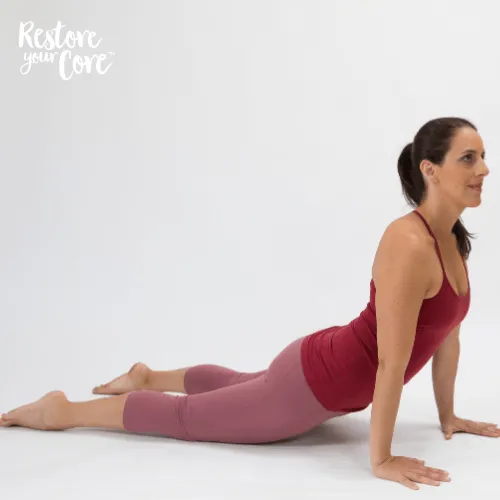| Refresh | This website restoreyourcore.com/learn/postpartum/postpartum-workout-plan/ is currently offline. Cloudflare's Always Online™ shows a snapshot of this web page from the Internet Archive's Wayback Machine. To check for the live version, click Refresh. |

Lauren Ohayon is the creator of Restore Your Core® (RYC®), a comprehensive and sustainable whole-body fitness program that empowers women to achieve ideal pelvic floor / core function and be strong, long, mobile and functional.

Giving birth takes a toll on your body – both physically and emotionally. Many postpartum people will feel overwhelmed and exhausted after giving birth, which can make it difficult to return to a daily regimen. Other people, especially those who had a regular workout plan before and during their pregnancy, may attempt to get back to their fitness regimen before they are ready. It is important to have a postpartum workout plan, but how do you know when it is the right time to begin?In this article I hope to answer your most pressing questions regarding postpartum exercise and when to begin.
Get free expert advice and start your postpartum healing journey today
Table of Contents
Before you begin a strenuous exercise routine, it is important that you have clearance from your medical provider to begin exercising. This is especially true if you have had a c-section or had a complicated pregnancy or birth. In most cases, people who had a vaginal delivery can begin light physical activities a few weeks post pregnancy. Yet, you should only begin exercising as you are able.
During your 8 week postpartum check up, your doctor will most-likely recommend beginning returning to your normal pre-pregnancy routine. This can include light exercise and beginning to develop a workout plan for the months ahead. It is important that during this time you take it slow. Focusing more on spending time with your baby, your mental health, and making gradual steps toward recovery are more important than trying to lose weight fast or regaining that sexy, pre-pregnancy body.
Over the first 8 weeks or more, you may gradually integrate workouts as you regain strength in your core, upper and lower body, and neck. Ensuring that you make smart choices in your workout plan can help prevent overexertion, postpartum pain and bleeding, and help you reach a safer, sustained postpartum recovery.
It is true that 8 weeks or more can feel like a very long waiting period, but your overall health is more important than a slim body. However, making sure that the early stages of your recovery are done carefully can help you get back to a more intensive postpartum workout plan safer and sooner. Rest, hydration, and nutrition should be the focus in the early stages of your recovery.
Take 3 steps toward doing the things you love again postpartum
The appropriate time to begin postpartum workouts varies depending on your delivery experience. As mentioned above, many women who delivered their child without any complications or if they delivered vaginally, may begin with light exercise (i.e. walking, food prep, household activities) only a few weeks after their delivery. Women who delivered via c-section or experienced complicated birth, should wait until the 8 week mark, or talk with their medical provider before starting a fitness plan. I always recommend waiting at least 8 weeks, regardless of delivery method, in order to approach recovery well and safely.
Building a smart postpartum workout plan and returning to a consistent fitness routine may help many postpartum people close their diastasis recti gap, begin strengthening their pelvic floor, and help reduce baby weight. Some women may benefit by experiencing a sense of normalcy as they begin returning to their pre-pregnancy routine, others may benefit by having time dedicated to personal health and recovery – both with their bodily and mental health. Some of the primary benefits of building a postpartum workout plan include:
Discover the top 3 steps to regain your fitness and strength postpartum–free
When you first begin your postpartum workout, it is important that you begin focusing on the major muscle groups that have been affected by your delivery. Engaging in short-term periods of basic exercises (10 to 20 minutes) a day is a great place to start. As you continue to build strength, increase the time and intensity of your exercises as you are able. Whether you enroll in a program like Restore Your Core or plan your own workouts for postpartum recovery, a consistent, safe fitness plan can help prevent injury and relieve postpartum symptoms.
Below are some helpful exercises you can do to help build core and lower body strength.
Core exercises can be a great way to begin restoring core health, function, and strength after giving birth. During your pregnancy, it is very common to experience a weakening of connective tissues and your abdominal muscles, especially postpartum. Many women will experience diastasis recti at some point during or after their pregnancy. Although it is recommended to allow for your body to heal properly before beginning most core exercises, there are a few that we recommend in your postpartum workout.
Get 3 (free) scientifically-proven steps and regain your postpartum strength and fitness
Your body undergoes many significant changes during and after your pregnancy. The additional weight your baby added to your belly can affect your shoulders, upper and lower back, as well as your core, body, and organ alignment. One of the most helpful exercises in our program is the floor angel.
There are many exercises you should avoid during the first 8 weeks of your postpartum recovery. In our program, Body Ready Method®, we firmly believe in a 5-5-5 program during the first 2 – 4 weeks before getting back into a more strenuous routine. 5-5-5 means spending 5 days resting in bed, 5 days around your bed, and 5 days within close proximity of your bed. After those two weeks are up, you can begin introducing walking and other light exercises.
Whether you are still feeling pain or feel totally fine after delivering your baby, it is extremely important that you take it slow. Performing the wrong exercises may be unhelpful to your body as it is trying to heal from a fairly large internal injury.
Avoid any exercises that apply unnecessary pressure or strain to your belly and midline. This means you should avoid any exercises that cause your belly to bulge (sit-ups, planks, squats, etc). This can cause any separation you may have experienced to worsen and can be very painful.
It is also important to avoid any heavy lifting or twisting in ways that can affect your abdomen or vaginal wall. Avoid exercises like crunches, oblique curls, roll-ups, or any similar exercises.
It may also be helpful to avoid yoga poses such as backbends or other spinal extensions as they, too, increase intra-abdominal pressure. Additionally, following advice from any flat belly programs or fast, baby weight reduction programs are a no-go. One of the most damaging lies our culture tries to instill in new mothers is that they should quickly begin trying to regain a bikini body or slim appearance.
If you are looking for a no-BS, helpful recovery program for your postpartum recovery, consider checking out our 12-week program: made by women, for women.

“There is no thank you big enough for Lauren Ohayon existing and thinking and helping so many of us. Every time I do something I never thought I’d do again she is part of the reason why.”
Laura Gregg
in this FREE video and get the support you deserve

Postpartum physical therapy can be a great way to restore function and strength in your core and pelvic floor muscles. Giving birth places a strain on your body and it...

The postpartum recovery period typically lasts well beyond common expectations. Guiding and supporting your postpartum patients and clients through this transitional period requires effective strategies tailored to their individual needs....

Postpartum recovery can be difficult for anyone, but there are particular considerations to keep in mind after a C-section. Read on to learn more about how to begin a safe...

Have you just had a baby, or are you about to give birth? Read on for pelvic floor exercises that facilitate faster postpartum recovery, enhance overall well-being, and improve long-term...

Introduction Pregnancy and delivery are a massive undertaking. Your body has to adapt and expand to allow the baby to grow, and having a C-section means you face a whole...

It is not uncommon for many postpartum people to experience complications such as pelvic organ prolapse postpartum. Vaginal and rectal prolapse occur when the supporting muscle and tissue structures become...

Before you begin any exercise routine, consult with your doctor for medical clearance. Practice patience with yourself and your body, and rest, lots of rest! I recommend waiting at least...

Post-pregnancy pain, whether it be pelvic floor pain or joint pain, is a shared experience among many postpartum people. However, postpartum pain, especially in pelvic pain, can vary in frequency,...

*No spam, just quality content and support
Please check your inbox soon.

Take 3 steps toward doing the things you love again postpartum
© 2025 RYC®. All rights reserved.
in this FREE video and get the support you deserve